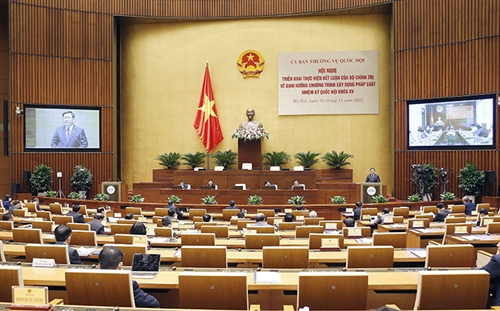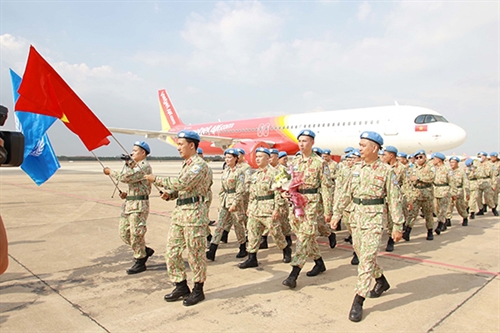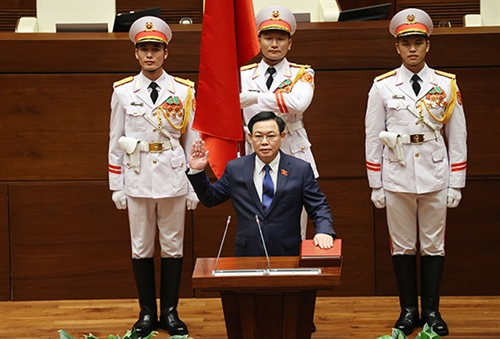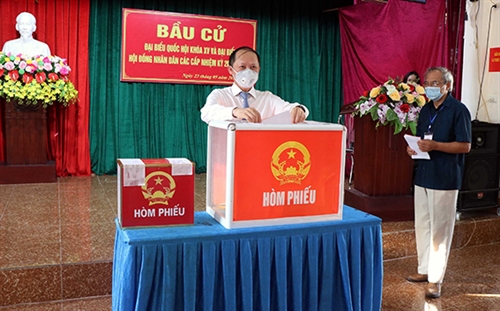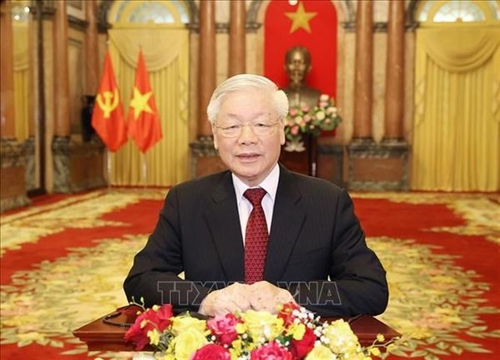Vietnam became an official member of the World Trade Organization (WTO) 15 years ago on November 7, 2006. Since then, the country has made big strides on the path of international integration, confidently joining the global playground. The country’s total import-export value has increased by six times over the 2006’s figure, reaching around USD 545 billion in 2020.
With 17 free trade agreements (FTAs) for which negotiations have been completed or are underway, Vietnam has become an open economy with a trade-to-GDP ratio of up to 200 percent. Especially, the country has taken advantage of international integration to boost export while effectively controlling import, thus helping shift from trade deficit to trade surplus.
Great achievements attained
According to the Agency of Foreign Trade under the Ministry of Industry and Trade, Vietnamese businesses have managed to maximize advantages to boost export and penetrate into new markets.
Statistics showed that Vietnam’s total import-export value in 2006, the year when the country joined the WTO, was just USD 84.7 billion with a trade deficit of USD 5.1 billion. In 2020, the country’s total import-export value mounted to USD 545.3 billion with a trade surplus of USD 19.9 billion. In the first 10 months of this year, the figure was USD 537.31 billion.
Vietnam had successfully kept an annual export growth rate of 15 percent throughout the 2007-20 period. Export turnover increased from USD 48.6 billion in 2007 to nearly USD 176.6 billion in 2016 and reached approximately USD 282.6 billion in 2020.
The country also recorded an average import growth rate of around 14.2 percent per year during 2007-20 with import turnover rising from USD 62.8 billion in 2007 to some USD 175 billion in 2016 before mounting to USD 262.7 billion in 2020.
Significantly, Vietnam succeeded in improving its balance of trade, gradually reducing trade deficit from USD 14.2 billion in 2007 to approximately USD 3.8 billion in 2015. From 2016 onward, the country has always recorded a trade surplus, from USD 1.6 billion in 2016, to USD 1.9 billion in 2017, USD 6.5 billion in 2018, USD 10.6 billion in 2019, and USD 19.9 billion in 2020.
Another noteworthy achievement is positive change in the country’s export structure. The proportion of processed industrial goods to export turnover increased from 80.3 percent in 2016 to 85.2 percent last year. Meanwhile, the proportion of fuel and mineral products dropped from 2 percent of the total export value in 2016 to 1 percent in 2020. The number of commodity items with annual export turnover surpassing USD 1 billion gradually increased from 28 in 2016 to 31 in 2020.
As for import, the proportion of import turnover of processed or refined goods to the total import value increased from 73.33 percent in 2007 to 80.8 percent in 2019. In the reverse direction, raw and preliminarily processed products’ proportion in import turnover dropped from 24.57 percent in 2007 to 19.1 percent in 2019. In 2020, nearly 88 percent of import value came from commodity items that need to be imported for production and export while commodity items discouraged for import accounted for below 6 percent.
The accession to the WTO and conclusion of FTAs have also helped Vietnam boost export in a quick and sustainable manner and step by step reduce dependence on several export markets. On average, export goods with preferential C/Os under FTAs make up 32-34 percent of the annual export turnover.
According to the WTO’s World Trade Statistical Review 2020, among the top 50 merchandise traders, Vietnam recorded the biggest increase in the world’s rankings, leaping from the 39th place in 2009 to the 23rd position in 2019.
The signing and implementation of FTAs also give the country opportunities to better attract foreign direct investment, creating a momentum for boosting economic growth.
As evaluated by the Global Competitiveness Reports of the World Economic Forum (WEF), Vietnam had jumped 13 ranks in the Global Competitiveness Index over 10 years, from the 68th position among 131 economies in 2007 to the 55th place among 137 economies in 2017. In 2019, the country leaped 10 ranks in terms of this index against 2018 to take up the 67th position out of 141 economies.
 |
| A manufacturing chain of Thaco Automotive Body Parts Manufacturing Co., Ltd. in Chu Lai Open Economic Zone, Quang Nam province__Photo: Danh Lam/VNA |
The challenges ahead
Success does not happen overnight. The achievements gained by Vietnam after 15 years of accession to the WTO reflect the country’s determination to pursue comprehensive policies on restructuring the economy combined with renewal of the growth model.
However, limitations still exist and, in order to attain sustainable economic development goals, Vietnam has to resolve several problems.
In an article published in Tap chi Cong san (Communist Review), Dr. Pham Vinh Thang and Dr. Doan Cong Khanh from the Banking Academy pointed out five issues facing the country’s foreign trade.
Firstly, Vietnam’s export on the one hand grows rapidly but on the other hand lacks sustainability and remains vulnerable to external shocks. Almost all commodity items which witness a high export growth rate and account for big proportions in the country’s export turnover either have limitations in constituent factors such as productivity, material area and exploitability (e.g., agricultural products, fishery products and mineral products) or rely too heavily on overseas technologies, raw materials and markets (leather-footwear and textile-garment).
Another factor that can be attributed to the vulnerability of export growth is the increase in the number of cases of trade remedies investigations against goods from Vietnam. Since the first anti-dumping lawsuit against Vietnamese rice in 1994, which was initiated by Colombia, on average, the country has faced 2-3 anti-dumping lawsuits every year. Particularly in 2020, the number of anti-dumping lawsuits against Vietnamese exports hit a record high with 37 cases, a more than twofold increase compared to the 2019’s figure.
Secondly, Vietnam has managed to restructure its export markets to reduce excessive dependence on some traditional partners and, as a result, Vietnamese goods are now present in almost all countries and territories around the world. However, such restructuring is mostly aimed to adapt to circumstances rather than based on a long-term vision and, therefore, has quickly revealed shortcomings. Putting too much focus on certain markets would reduce the possibility of expanding new markets, making it difficult to attain sustainable development and maintain a high growth rate.
Thirdly, Vietnam’s greenhouse gas emissions are quite alarming, especially in two spearhead sectors: processing-manufacturing industries and export processing.
Fourthly, from 2007 until now, Vietnam’s import has largely relied on Asian markets, especially China. With most of the country’s trade deficit coming from Asian markets and trade surplus to markets possessing source technologies, Vietnam is now following the “flying geese paradigm” but seemingly stuck at the low added-value production stage of the global value chain, posing a high threat of being lagged behind.
Fifthly, for the time being, machinery, equipment, tools and accessories account for 41 percent of the total import value but most of them belong to the group of intermediate technologies and medium-level technologies, thus failing to create a strong momentum for production restructuring.
Recommendations
Against the current backdrop, increasing export value, boosting import efficiency and improving competitiveness are pressing issues that need to be redressed in the immediate future. In their article, Dr. Thanh and Dr. Khanh suggested several solutions to deal with the situation.
According the two experts, Vietnam needs to improve policies and mechanisms to encourage technological innovation to raise competitiveness of Vietnam’s exports and promote the production of import substitutes.
Regarding export, it is the right time to change the export market structure, refraining from “putting all eggs in one basket” while maintaining important traditional markets and taking into consideration niche markets so as to take every opportunity, even the smallest one, brought about by new-generation FTAs such as the CPTPP, EVFTA and UKVFTA.
Enhancement of a channel for transmission of information to businesses is another job to do. In the near future, the number of lawsuits and retaliatory measures against Vietnam’s exports will probably rise. Hence, local businesses should be timely provided with necessary information to prepare themselves for these circumstances. Furthermore, businesses should be assisted to improve their capacity up to requirements of importing countries, ranging from ways to deal with technical barriers to methods to approach and follow rules, standards and technical regulations of importers as well as international commitments on specific products.
Furthermore, in order to boost the participation of local businesses in the global supply chains, enterprise workers should be trained in necessary skills and knowledge such as market survey, marketing and international negotiation skills, foreign-trade knowledge, and foreign-language and informatics competencies.
Regarding import, it is necessary to further expand and diversify import markets, thus avoiding excessive dependence on certain partners while attaching special attention to big partners and partners that possess high technologies and source technologies. In addition, promotion of import from niche markets may be taken into consideration. The list of imports subject to specialized management should be reviewed and technical conditions applicable to each item should be specified. The State may also consider integrating environmental protection tax into the import duty system and applying on a trial basis the mechanism on auction of import permits for commodity items exerting an adverse impact on the ecological environment.
Regulations of the WTO and FTAs should be implemented in a flexible manner, taking the initiative in applying such measures as anti-dumping duty, countervailing duty and other safeguard measures as well as technical, labor and environmental standards to control import; formulating technical barriers in conformity with the country’s international commitments; and enhancing market surveillance to fight smuggling, counterfeit goods, and trade frauds.
In addition, current laws and policies on import such as the Commercial Law, the Law on Import Duty and Export Duty, etc., should be scrutinized and revised to be compatible with Vietnam’s international commitments as well as treaties which the country has concluded or is negotiating for.
In general, Vietnam should expand cooperation with other countries and territories and consolidate and improve national competitiveness as well as competitiveness of Vietnamese businesses and products. Markets should be opened in parallel with control of products’ and goods’ quality and formation of supply chains with the participation of Vietnamese businesses and partners. The country should also update FTA strategies, prudently selecting negotiation partners based on set principles while boosting domestic consumption.-
